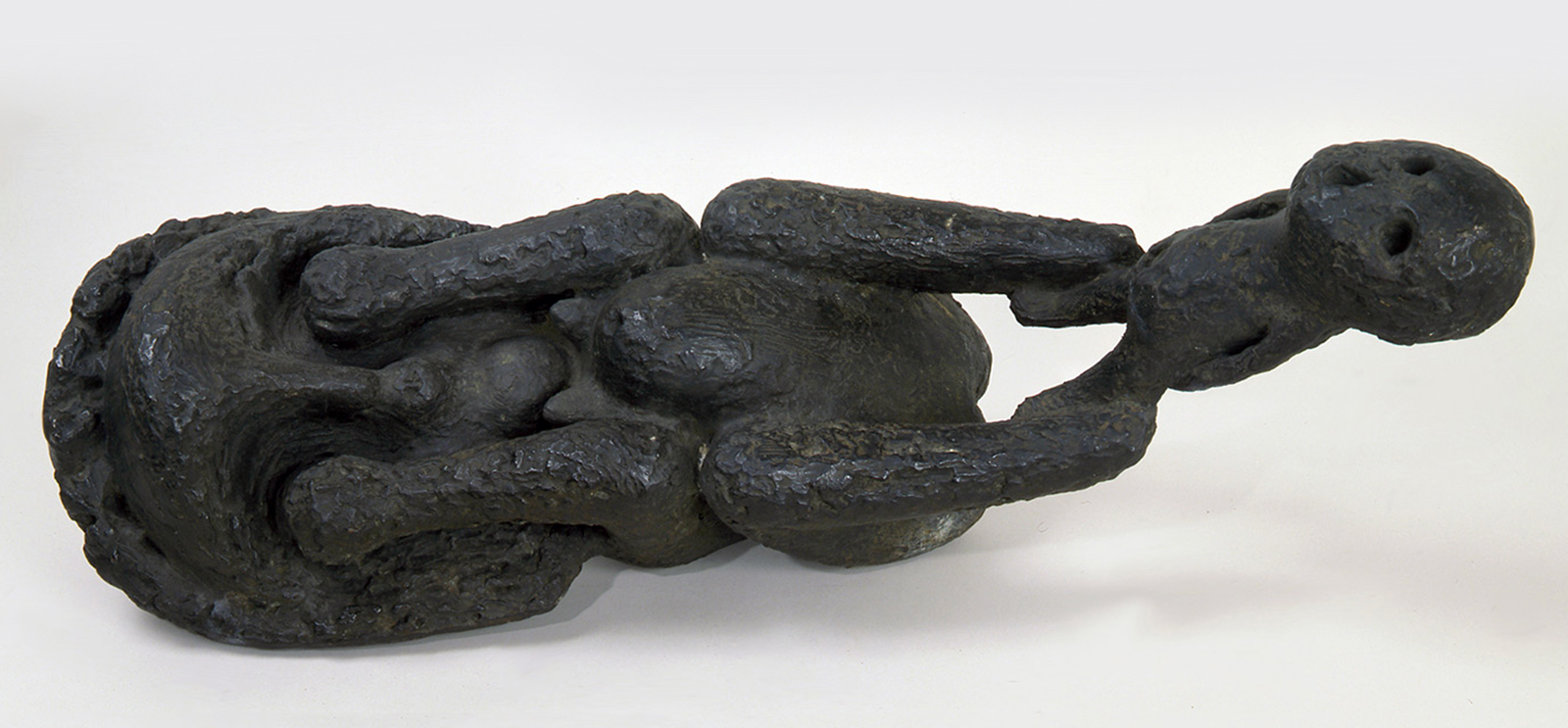
Cosmo Campoli, Birth of Death, 1950–1951, cast bronze. Smart Museum of Art, the University of Chicago, gift of Joyce Turner Hilkovitch in memoriam of Jonathan B. Turner, 1991.357.
The first art movement to originate in Chicago focused on the dark side of postwar life.
Six years ago, independent curators John Corbett and Jim Dempsey started planning a show comparing the Monster Roster, the first major art movement to originate in Chicago, to a contemporaneous group in Europe. To their surprise, they found that the Monster Roster had never been the subject of a significant exhibition before. Small shows had been mounted over the years, but they didn’t delve into the relationships between the artists or their shared intellectual concerns.
“It was a major gap in the exhibition history of Chicago’s art lineage,” Corbett says. He and Dempsey put together a proposal for a “depth survey” of the group, and the show quickly found a welcoming home at the Smart Museum of Art. Monster Roster: Existentialist Art in Postwar Chicago, at the Smart through June 12, features approximately 60 works by 16 artists. The exhibition is curated by Corbett, Dempsey, and Smart Museum curators Jessica Moss and Richard A. Born, AM’75.
The artists represented never formed a group or referred to themselves as the Monster Roster. The term first appeared in print in a 1959 art review by artist and critic Franz Schulz, PhB’45. It hit the mark. The distorted and expressive figurative works, created between 1948 and the early 1960s, seem to inhabit a common world, dark in palette and tone. For this circle, the collective anxiety of the postwar atmosphere became source material.
With a focus on the human figure, the works often reimagined classical mythology or ancient tropes through a dark, psychoanalytic lens. Many of the male artists in Monster Roster were veterans of World War II. “Existentialist” in the exhibition title, says Corbett, “suggests that there is a non-art element that was important to where they were coming from.” On the whole, Monster artists were deeply intellectual and drawn to psychoanalysis. Some got their introduction to psychoanalysis and existentialism on campus.
“The University of Chicago was a hotbed for a lot of the intellectual concerns of these artists,” says Corbett. “These are artists that were reading Sartre, Camus, Beckett … and were interested in the fate of humanity and debating it both through images and through words.” Ten works in the exhibition—including two monumental canvases, Reclining Youth (1959) and Colossal Figure (ca. 1961)—are by Leon Golub, AB’42, known for his raw life-size paintings critiquing the horrors of war. Golub was taking art classes at UChicago as a humanities grad student when he enlisted in the army. He returned in 1946 and, under the GI Bill, attended the School of the Art Institute of Chicago.
In the 1988 Kartemquin Films documentary Golub, the painter spoke about the impact of war and violence on his work. “Monsters exist,” he said, “because we create them.” Don Baum, PhB’46, is also represented in the exhibition. As director of the Hyde Park Art Center from 1956 to 1972, Baum championed Chicago artists. He spoke in a 1986 oral history about the impact of psychoanalysis on his fellow artists, like Golub and June Leaf. “There was a lot of conversation about it,” he remembered. “I feel like a certain kind of methodology that I have about my own work—my dependence on intuition, the sort of experimentation which led to discovering my images in my own work—came directly out of that kind of psychoanalytic experience.”
Other UChicagoans helped give the Monsters’ work more exposure. The art dealer Allan Frumkin, PhB’45, mounted many of the artists’ first gallery shows. The brother of Reva Logan, EX’43—for whom the Logan Center for the Arts is named along with her husband, David Logan, AB’39, JD’41—Frumkin represented Golub in his Chicago and New York City galleries. Art historian Peter Selz, AM’49, PhD’54, also helped to introduce Chicago artists to the New York City art scene. All of this makes the Smart Museum an apt setting for the exhibition.
“It is a great way to shine a light on the underappreciated, lesser-known but really fascinating artists who created the first original art movement in Chicago,” says Moss. When choosing which works to include, the exhibition’s curators were surprised to find how many artists were part of the core movement or related to it. “We thought it would be much smaller,” says Corbett. Since the Monster Roster wasn’t a self-identifying group, the lines are hard to draw distinctly. Robert Barnes rejected the label of Monster Roster, but Corbett included an early Barnes painting, For Tristan Tzara (1965), because its enigmatic subject and figurative style share the Monster ethos.
Also included “by affinity, not as a stylistic exponent,” is H. C. Westermann, a contemporary of the artists in the group. Westermann witnessed fiery kamikaze attacks as a Marine during World War II, and pieces like his sculpture in the show, Ghost (Death Ship) (1964–65), are preoccupied with death.
In searching for images, Dempsey contacted the Hyde Park Art Center and was handed research gold—a roll of undeveloped film shot during a small Monster Roster exhibition in 1964. The photographs reveal a charming, low-budget effort with wall labels made of embossing tape. Corbett and Dempsey pondered the timing of the show. Why now, they asked themselves. They kept returning to the themes that gripped the Monster Roster artists.
“These are the kinds of questions that we are asking ourselves today,” says Corbett. “The plight of being on this planet is wholly relevant once again.”
